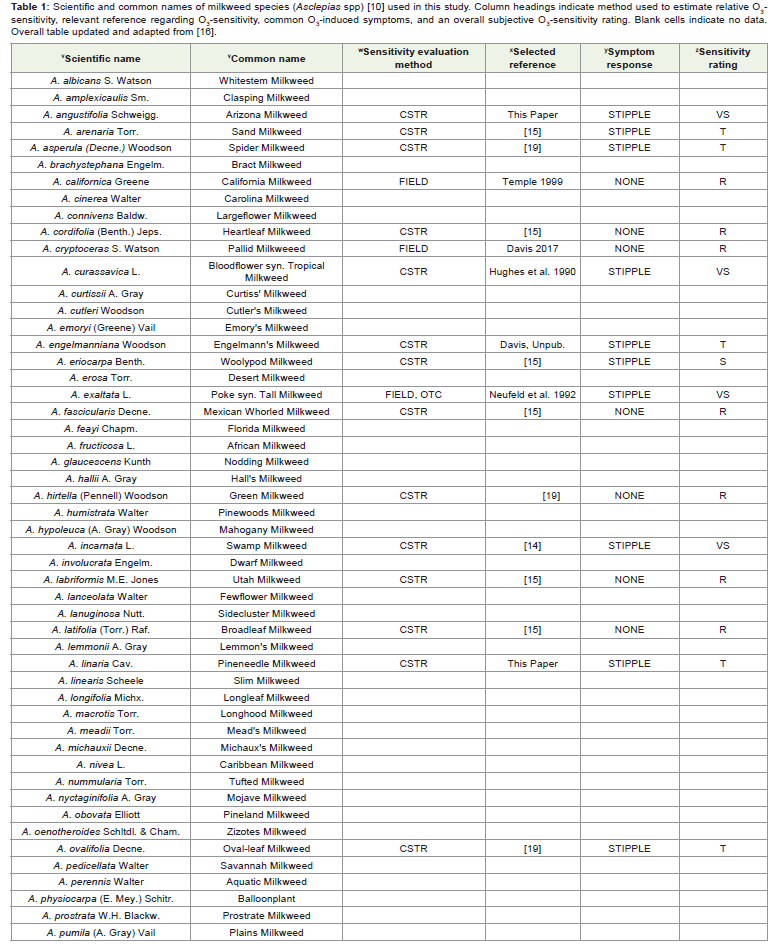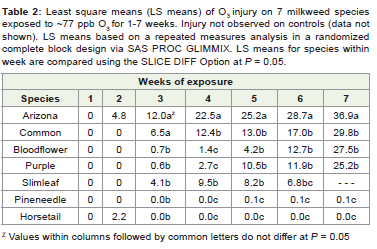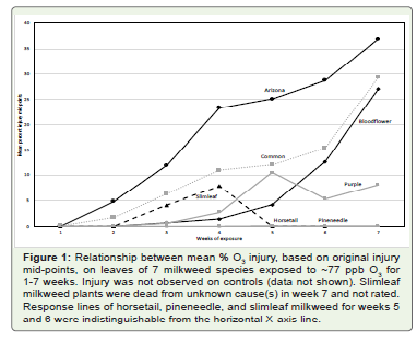Ozone-Sensitivity of Seven Milkweed Species (Asclepias spp)
Mercado ME1, Decoteau DR2, Marini RP2 and Davis DD3*
1Department of Plant Pathology and Environmental Microbiology, The Pennsylvania State University, USA
2Department of Plant Science, The Pennsylvania State University, USA 3Department of Environmental Microbiology, The Pennsylvania State University, USA
2Department of Plant Science, The Pennsylvania State University, USA 3Department of Environmental Microbiology, The Pennsylvania State University, USA
*Corresponding author: Davis DD, Department of Environmental Microbiology, The Pennsylvania State University,University Park, PA, USA, Email: ddd2@psu.edu
Copyright: © Mercado ME, et al. 2021. This is an open access article distributed under the Creative Commons Attribution License,which permits unrestricted use, distribution, and reproduction in any medium, provided the original work is properly cited.
Article Information: Submission: 11/11/2020; Accepted: 11/03/2021; Published: 15/03/2021
Abstract
Tropospheric ozone (O3) is considered to be the most important phytotoxic air pollutant across many parts of the USA and continues to be of major
concern in natural ecosystems worldwide. Milkweed species (Asclepias spp) are among the most O3-sensitive plants that occur in natural ecosystems, as
well as a weed in agricultural systems. Seven milkweed species were exposed to O3 during 2020 within controlled-environment chambers in a greenhouse.
Arizona, bloodflower (syn. ornamental), and common milkweed developed the greatest O3-induced leaf injury (“stipple”) and were considered to be very
sensitive to O3. The response of purple milkweed was variable. Slimleaf milkweed exhibited low levels of leaf stipple and was considered tolerant. Horsetail
and pineneedle Milkweed were considered resistant to O3. Results were entered into a master table, which now lists the relative O3-sensitivity of 27 of 76
(36%) milkweed species common in the USA.
Introduction
Tropospheric ozone (O3) is considered to be the most important
phytotoxic air pollutant in many parts of the United States (USA) and
continues to be of major concern in natural ecosystems worldwide
[1,2]. O3 is a secondary air pollutant formed when oxides of nitrogen
(NOx) and volatile organic compounds (VOCs) react in the presence
of sunlight. Tropospheric concentrations vary seasonally, generally
being greater in summer and minimal in the winter across the USA
[1,3]. O3 levels also vary daily, typically following diurnal patterns with
concentrations low in early morning, increasing in late afternoon,
and minimal at night [1,3-5].
On 1 October 2015, the US Environmental Protection Agency
(EPA) strengthened the USA National Ambient Air Quality Standard
(NAAQS) for O3, reducing the level of the standard from 75 to 70
ppb [6]. This more stringent NAAQS is based on the 4th highest daily maximum of an 8-hr average O3 concentration across 3 consecutive
years. The reduction makes the new O3 NAAQS more stringent to
help protect public health and welfare in the USA, including the
health of O3-sensitive plants such as milkweed.
Milkweeds (Asclepias spp) are classified within the family
Asclepiadaceae. Agrawal [7] estimated that milkweed species in the
Americas numbered ~130. Woodson [8,9] listed ~105 indigenous
milkweed species in North America alone. The US Department of
Agriculture (USDA) now lists 76 milkweed species found growing in
the USA [10]. Scientific and common names of those 76 species are
used in this paper (Table 1).
Milkweed species reported to be sensitive to O3 include common
[11], bloodflower (syn. tropical) [12], poke (syn. tall) [13,14], and
swamp milkweed [15]. However, most milkweed species in the USA
have not been evaluated for O3 -sensitivity. Prior to this paper, only 22 of the 76 (29%) milkweed species listed in (Table 1) had been evaluated
for O3-sensitivity [16].
Table1: Scientific and common names of milkweed species (Asclepiasspp)[10] used in this study. Column headings indicate method used to estimate relative O3-sensitivity, relevant reference regarding O3-sensitivity, common O3-induced symptoms, and an overall subjective O33-sensitivity rating. Blank cells indicate no data. Overall table updated and adapted from [16] .
The objective of this study was to evaluate the O3-sensitivity
of 7 milkweed species and to determine or confirm their relative
sensitivity or resistance by updating a master list previously compiled
by the authors [1].
Materials and Methods
Ozone exposure chambers:
O3 exposures were conducted within 16 continuous stirred tank
reactor (CSTR) chambers [18] in a greenhouse on the University
Park campus of The Pennsylvania State University (40°48’20”N,
77°51’08”W). O3 concentrations within each chamber were monitored
using a photometric OO3 analyzer (Model 49,Thermo Environmental
Corp., Franklin, MA). O3 treatments were administered, monitored,
and controlled via a computerized system during exposures, which
also monitored and displayed temperature and relative humidity in
each chamber [19].Exposure study:
Plant Culture: Plant culture followed protocols of Myers et al.
[20]. Arizona, bloodflower, common, horsetail, pineneedle, purple,
and slimleaf milkweed were selected based on availability of seeds.Common milkweed was included as a standard, since this species
is known to be highly sensitive to O3 [11,12]. During August 2020,
milkweed seeds were placed in 2-L pots containing moist potting mix
with ~1g slow-release fertilizer (15N-4P-10K) and watered as needed.
Resultant seedlings were grown in a greenhouse containing air that
passed through activated-charcoal filters, reducing the ambient
greenhouse O3 to ~5 ppb.Plant exposure to O3: O3 exposures began in mid-September
2020. TwoO3 treatments were used (elevated vs control). Our target
value for the elevated O3 concentration was 75 ppb since various
milkweed species had exhibited classic O3-induced leaf stipple
following exposure to this concentration during previous studies
conducted within these chambers [17,20]. However, the mean O3
concentration within the exposure chambers was better controlled
at ~77 ppb, which was thus used in this study. The average OO3
concentrations in the control chambers were ~5 ppb, which was the
lowest concentration that could be attained using the charcoal-filter
system that scrubbed the air within both the greenhouse and control
chambers. Fourteen chambers were maintained at ~77 ppb O3 and
2 control chambers were kept at~5 ppb O3. We had planned to put
2 plants/species in each chamber. However, due to reduced seed
germination and decreased seedling survival, the number of plants/
species varied from 0-2/chamber.
Milkweed plants were exposed for 7 weeks, 6 days/week, 8h/
day (0900-1700 hours), in a square-wave design. During exposures,
mean air temperature was ~25oC and relative humidity was ~44%.
Once a week, plants were watered, redistributed randomly within
each chamber, and O3-induced foliar stipple evaluated. Following
each weekly 6-day exposure, plants remained within the same CSTR
exposure chambers with the chamber doors open until the next
exposure began.
Leaf injury (stipple) evaluation: O3-induced foliar stipple on
the upper leaf surface/plant was visually estimated [17,20] within
each chamber using a modified Horsfall-Barratt scale [21]. Symptom
rating classes in this scale ranged from 0 to 5, where 0 = no injury,
1 = 1-6% injury, 2 = 7-25%, 3 = 26-50%, 4 = 51-75%, and 5 = 76-
100% injury. To provide a single value for statistical analyses, the
midpoint of each class was calculated as the mean of the minimum
and maximum percentage.
Data Analyses:
Analyses of O3 response data were conducted
using a repeated measures analysis in a randomized complete block
design as described in SAS PROC GLIMMIX [22]. Chamber was
the block; random effects included chamber and plants nested in
chamber. Since the (week x species) interaction was significant (P
= 0.0001), the Least Squares means (LS means) for species within
week were statistically compared using the SLICE DIFF Option at P
= 0.05. LS means can be defined as a linear combination (sum) of
the estimated effects (means) from the linear model. When the data
contain no missing values, the LS means and arithmetic means are
identical. When missing values occur, the two will differ and the LS
means are preferred, because they reflect the model that was used
to fit the data. When the data are extremely unbalanced, as in this
study, the estimated LS means may differ greatly from the arithmetic
means, because there are too few observations to make appropriate
adjustments. Since the standard errors from the repeated measures
are correct, the multiple comparisons for LS means in (Table 1) are
correct, and the arithmetic means are presented in (Figure 1).Results
Results based on Least Squares means: Control plants did not exhibit O3-induced foliar injury (data not shown). Foliar injury was
not observed on any species following 1 week of exposure to ~77 ppb
O3. At 2 weeks, light stipple was noted on Arizona milkweed and
extremely light stipple on horsetail milkweed (Table 2). Following 3 weeks of exposure, more severe O3 injury was observed on Arizona,
bloodflower, common, purple, and slimleaf milkweed. At 3-4 weeks,
stipple was noted on all species except horsetail and pineneedle
milkweed. Following 5-7 weeks exposure, stipple occurred on all
species except horsetail milkweed. Slimleaf milkweeds in both the
control and exposure chambers began to die from unknown causes at
5 weeks and all were dead by 7 weeks.
Although PROC GLIMMIX estimated the LS means for slimleaf
milkweed on week 7, the value is questionable since there were
no living slimleaf milkweed plants at this time (Table 2). After
the 7th and final rating, O3 injury based on LS mean mid-point
ratings of the various milkweed species, from greatest to least, was:
[Arizona (36.9%)>common (29.8%)=bloodflower (27.5%)=purple
(25.2%)>pineneedle (0.1%)=horsetail (0.0%), and slimleaf
(undetermined due to 100% mortality)] (Table 2).
Table 2: Least square means (LS means) of O3 injury on 7 milkweed species
exposed to ~77 ppb O3 for 1-7 weeks. Injury not observed on controls (data not
shown). LS means based on a repeated measures analysis in a randomized
complete block design via SAS PROC GLIMMIX. LS means
Results based on mid-point arithmetic means: Results based on mid-point arithmetic means: Injury ratings
for Arizona milkweed were greater than all other species as early as
week 2, and increased nearly linearly through the study (FIgure 1).
The injury ratings for common and blood flower milkweeds increased
slowly for the first 5 weeks before increasing more rapidly in the final 2 weeks
Figure 1: Relationship between mean % O3 injury, based on original injury
mid-points, on leaves of 7 milkweed species exposed to ~77 ppb O3 for
1-7 weeks. Injury was not observed on controls (data not shown). Slimleaf
milkweed plants were dead from unknown cause(s) in week 7 and not rated.
Response lines of horsetail, pineneedle, and slimleaf milkweed for weeks 5
and 6 were indistinguishable from the horizontal X-axis line.
Discussion
Seven milkweed species were exposed to O3 during 2020. As
shown in (Table 1), Arizona, bloodflower, and common milkweeds
developed the greatest O3-induced leaf injury (“stipple”) and were
classified as “Very Sensitive”. The response of purple milkweed was
variable between (Table 2) (Figure 1) and Figure 1 and was classified as “Tolerant”,
but will be exposed again in the next study using more plants. Slimleaf
milkweed exhibited very low levels of leaf stipple and was considered
“Tolerant”. Horsetail and pineneedle milkweed exhibited either a
trace or no symptoms and were classified as “Resistant”. Slimleaf
milkweeds in both the control and exposure chambers began to die
from unknown cause(s) at 5 weeks (Figure 1). However, there was a trace of accumulated stipple on living slimleaf milkweeds after 4 weeks of exposure, so the species was classified as slightly “Sensitive”
to O3 (Table 1).
Milkweed species confirmed to be sensitive to O3 based on
previous reports include common[11] and bloodflower [12].
Common milkweed is a widely used bioindicator of phytotoxic levels
of tropospheric O3 across the USA [11,17]. Bloodflower milkweed is
likewise very sensitive to O3, but may not be acceptable to use as a bio
indicator in some regions of the USA since it may contain a protozoan
that is pathogenic to some butterflies, including the popular monarch
butterfly [7,17].
An important finding in this study, is that we reported for the
first time that Arizona milkweed is very sensitive to O3. The species
was the most sensitive of the 7 milkweed species from week 2 to
week 7 (Figure 1). Arizona milkweed is rare in the USA, being
found only in southern Arizona (and into northern Mexico), where
it grows in arroyos, canyons, along streambeds, and on slopes
(http://southwestdesertflora.com/WebsiteFolders/All_Species/
Asclepiadaceae/Asclepias%20angustifolia,%20Arizona%20).
The high O3-sensitivity of Arizona milkweed to O3 is significant,
since it was injured by ~77 ppb O3, a concentration that occurs
in the USA troposphere. In fact, in 2020 the US EPA reported
measuring ambient O3 concentrations as high as 90 ppb in Denver,
CO, likely a result of O311,7].
Arizona milkweed may be an excellent, new bio indicator to detect
phytotoxic levels of O3 in the arid Southwest, if its high sensitivity
to O3 is maintained in dry regions. In dry areas, droughts can induce
stomatal closure, which in turn reduce gas uptake, including uptake of
O3 and subsequent foliar injury [22], confounding O3 injury surveys.
Findings from this study added 5 new milkweed species to (Table 1) and confirmed the ratings of 2 others. Milkweed species, such as
Arizona milkweed, which are classified as “Very Sensitive” to O3,
should be considered for possible use as bio indicators to detect
phytotoxic concentrations of ambient O3. (Table 1) now lists the relative
O3-sensitivity of 27 of 76 (36%) milkweed species. We present this
updated list in hopes that other air pollution researchers will expand
and improve the ratings by evaluating the O3 sensitivity of additional
milkweed species during field surveys used in combination with
controlled O3 exposures [17].
Acknowledgements
We acknowledge funding from the Pennsylvania Department of
Environmental Protection, Bureau of Air Quality, Harrisburg, PA,
USA and The Pennsylvania State University, University Park, PA,
USA. This work was also supported by the USDA National Institute
of Food and Agriculture (NIFA) and Federal Appropriations under
Project PEN04564, Accession number 1002837.



